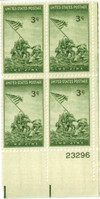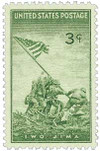
# 929 - 1945 3c US Armed Forces: Iwo Jima
U.S. #929
3¢ Iwo Jima
Issue Date: July 11, 1945
City: Washington, DC
Quantity: 137,321,000
Printed by: Bureau of Engraving and Printing
Printing Method: Rotary Press
Perforations: 10.5 x 11
Color: yellow green
When this stamp was first proposed, some people protested because it was planned to be printed in purple and because it would picture living people a violation of postal regulations. At the time, purple was the designated color for the 3¢ first-class letter rate, but postal authorities changed the color to Marine green. The USPS answered the other concern replying that the stamp didn't honor specific individuals, rather it honored the fighting spirit of the Marines on Iwo Jima. Despite these early objections, the stamp went on to become the most popular US commemorative at that time.
The stamp recreated the iconic Joe Rosenthal photograph of six Marines raising the flag over Mount Suribachi on February 23, 1945. The photo would go on to win a Pulitzer Prize for Photography and is considered one of the most recognizable images from the war.
The Battle of Iwo Jima
By early 1945, Japan had lost most of its empire and faced certain defeat, but its soldiers continued to fight. To make their Pacific campaign successful, the Allies needed more bases. In particular, they needed a place where their damaged B-29 bombers could land and be repaired without having to travel all the way to the Mariana Islands. A tiny island approximately 750 miles south of Japan became their primary target Iwo Jima. At the time, Iwo Jima was occupied by about 21,000 Japanese army and navy troops.
Eight months before the actual invasion, American ships and aircraft began bombing Iwo Jima in the longest and most intense bombardment of the Pacific theater. Many suspected the Japanese on the island to be largely wiped out, but a secret tunnel system had kept them safe.
Then at 8:59 a.m. (one minute ahead of schedule) on February 19, 1945, the battle began when the 3rd, 4th, and 5th US Marine divisions landed on Iwo Jima. The Japanese had prepared elaborate mine fields and underground tunnels, and a remarkable communications system for the islands defense. The fight for Iwo Jima proved to be one of the bloodiest battles of the war.
As the Marines crossed the beach they came under heavy mortar and rifle fire, and soon found they couldn't even construct foxholes in the soft black volcanic sand. As the Marines moved forward, the Japanese opened fire from their steel-doored tunnels and then quickly closed the doors to avoid the return fire. Even after the Americans cleared tunnels with flamethrowers, the Japanese would reoccupy them and launch a surprise attack from an area believed to be clear.
By the end of the first day, some 30,000 Marines landed, and would later be joined by another 40,000. The battle raged for several days, with the Japanese launching sneak attacks at night. The Sherman M4A3R3 tanks, equipped with flamethrowers, helped to clear Japanese positions. Navajo Code Talkers bilingual Navajo recruits that sent messages in their native tongue sent and received over 800 messages in the first two days. They were immensely helpful in keeping the lines of communication open across the front. Eventually, the Japanese ran out of food, water, and supplies, and their attacks grew desperate.
On February 23rd, after five days of intense combat, the Marines captured Mt. Suribachi and hoisted the Stars and Stripes. A Pulitzer Prize winning photograph of this moment has become one of the most famous images of the war, and served as the model for the US Marine Corps War Memorial in Arlington, Virginia. After 36 days of fierce fighting, the Japanese surrendered on March 16th nearly 7,000 Americans lost their lives and about 19,000 more were injured.
A strategic location for the US in the last stages of the war, Iwo Jima served as a base for the P-51 Mustangs that escorted the formidable B-29s on their bombing raids, as well as an emergency landing airstrip.
U.S. #929
3¢ Iwo Jima
Issue Date: July 11, 1945
City: Washington, DC
Quantity: 137,321,000
Printed by: Bureau of Engraving and Printing
Printing Method: Rotary Press
Perforations: 10.5 x 11
Color: yellow green
When this stamp was first proposed, some people protested because it was planned to be printed in purple and because it would picture living people a violation of postal regulations. At the time, purple was the designated color for the 3¢ first-class letter rate, but postal authorities changed the color to Marine green. The USPS answered the other concern replying that the stamp didn't honor specific individuals, rather it honored the fighting spirit of the Marines on Iwo Jima. Despite these early objections, the stamp went on to become the most popular US commemorative at that time.
The stamp recreated the iconic Joe Rosenthal photograph of six Marines raising the flag over Mount Suribachi on February 23, 1945. The photo would go on to win a Pulitzer Prize for Photography and is considered one of the most recognizable images from the war.
The Battle of Iwo Jima
By early 1945, Japan had lost most of its empire and faced certain defeat, but its soldiers continued to fight. To make their Pacific campaign successful, the Allies needed more bases. In particular, they needed a place where their damaged B-29 bombers could land and be repaired without having to travel all the way to the Mariana Islands. A tiny island approximately 750 miles south of Japan became their primary target Iwo Jima. At the time, Iwo Jima was occupied by about 21,000 Japanese army and navy troops.
Eight months before the actual invasion, American ships and aircraft began bombing Iwo Jima in the longest and most intense bombardment of the Pacific theater. Many suspected the Japanese on the island to be largely wiped out, but a secret tunnel system had kept them safe.
Then at 8:59 a.m. (one minute ahead of schedule) on February 19, 1945, the battle began when the 3rd, 4th, and 5th US Marine divisions landed on Iwo Jima. The Japanese had prepared elaborate mine fields and underground tunnels, and a remarkable communications system for the islands defense. The fight for Iwo Jima proved to be one of the bloodiest battles of the war.
As the Marines crossed the beach they came under heavy mortar and rifle fire, and soon found they couldn't even construct foxholes in the soft black volcanic sand. As the Marines moved forward, the Japanese opened fire from their steel-doored tunnels and then quickly closed the doors to avoid the return fire. Even after the Americans cleared tunnels with flamethrowers, the Japanese would reoccupy them and launch a surprise attack from an area believed to be clear.
By the end of the first day, some 30,000 Marines landed, and would later be joined by another 40,000. The battle raged for several days, with the Japanese launching sneak attacks at night. The Sherman M4A3R3 tanks, equipped with flamethrowers, helped to clear Japanese positions. Navajo Code Talkers bilingual Navajo recruits that sent messages in their native tongue sent and received over 800 messages in the first two days. They were immensely helpful in keeping the lines of communication open across the front. Eventually, the Japanese ran out of food, water, and supplies, and their attacks grew desperate.
On February 23rd, after five days of intense combat, the Marines captured Mt. Suribachi and hoisted the Stars and Stripes. A Pulitzer Prize winning photograph of this moment has become one of the most famous images of the war, and served as the model for the US Marine Corps War Memorial in Arlington, Virginia. After 36 days of fierce fighting, the Japanese surrendered on March 16th nearly 7,000 Americans lost their lives and about 19,000 more were injured.
A strategic location for the US in the last stages of the war, Iwo Jima served as a base for the P-51 Mustangs that escorted the formidable B-29s on their bombing raids, as well as an emergency landing airstrip.















